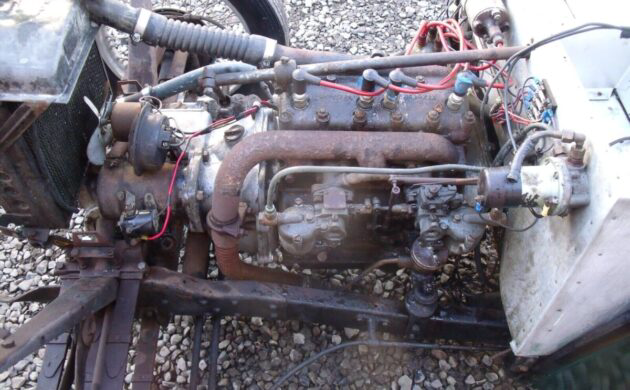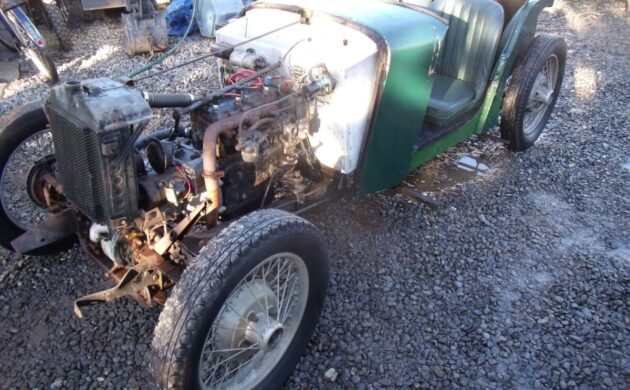Two for One: 1935 BSA Scout Automobiles
The 1935 BSA Scout Automobile was a unique vehicle that was introduced by the Birmingham Small Arms Company (BSA) for the 1935 model year. BSA was a British firm that had been manufacturing firearms and ammunition since the mid-19th century, and in the 1930s, it decided to venture into the production of cars. The Scout was the first model that BSA released and it was an immediate success. This ad is for the sale of two BSA Scouts located in Tacoma, Washington. The cars are listed here on eBay as a pair. With only one day remaining in the auction, the bids have reached $2,788 but the reserve has not been met.
The 1935 Scout was a two-door, four-seat touring car that featured a small four-cylinder engine and a three-speed manual transmission. It had a top speed of approximately 50 mph and could reach a fuel economy of up to 25 mpg. The car was also relatively lightweight, weighing in at only 1,800 lbs. Both cars included in the sale are said to be running or at least the engine runs. It is obvious that both need work or could be combined to make one operative vehicle.
The engine in the 1935 BSA Scout was a 4-cylinder, 1,087 cc side-valve engine. It had a single carburetor and produced only 9 horsepower in the Series I. The body of the car was made of aluminum and was considered to be a good handling vehicle in its day. The seller states that between the two Scouts, there is enough parts to build one car with the exception of the procurement of headlights. Extra parts are pictured and said to come with the sale included some rechromed parts and tires. Later versions were offered with larger, more powerful engines.
The BSA Scout was designed to be a reliable, affordable car that could be used for everyday transportation. It was well-built and sturdy, with a strong chassis and solid construction. The car also had a luxurious interior with leather seats, wood trim, and plenty of room for passengers. The 1935 BSA Scout was a great success, with over 4,000 units being produced in the first year alone. It was considered a popular car in its day.
Auctions Ending Soon
 2002 Subaru Impreza WRXBid Now6 hours$333
2002 Subaru Impreza WRXBid Now6 hours$333
 1975 Chevrolet Corvette ConvertibleBid Now7 hours$4,000
1975 Chevrolet Corvette ConvertibleBid Now7 hours$4,000
 1964 Ford F-100 Camper CustomBid Now8 hours$2,000
1964 Ford F-100 Camper CustomBid Now8 hours$2,000
 2006 Jeep Wrangler SportBid Now2 days$11,000
2006 Jeep Wrangler SportBid Now2 days$11,000
 1974 Datsun 260ZBid Now4 days$750
1974 Datsun 260ZBid Now4 days$750





Comments
“ BSA was a British firm that had been manufacturing firearms and ammunition since the mid–19th century, and in the 1930s, it decided to venture into the production of cars.”
Having made motorcycles since 1910 probably helped get it going on cars..
Ironically, in December of last year Mahindra announced the resurrection of BSA motorcycles.
https://www.bsacompany.co.uk/bsa-is-back/
https://newatlas.com/motorcycles/bsa-relaunch-mahindra/
https://thekneeslider.com/brand-new-bsa-motorcycles-for-2022/
How is that ironic?
Mahindra is an Indian company. India was very much a British Colony when this car was built. As the poet Shelley noted:
” Look on my works, Ye Mighty, and despair….”
Just my view I suppose, jwaltb in that two of the most iconic British motorcycle brands of their times (Royal Enfield and now BSA) were kept alive by a former British colony, India, to say nothing of the car companies Jaguar and Land Rover.
A timely quote, Martin Horrocks!
It’s hard to fathom, BSA making anything but guns and motorcycles but it shows that the maker was willing to branch out. It would be tempting to try this on but I think it would be better to let someone else do it…
Interesting- I had never heard of a BSA car. It appears that it is front wheel drive with the motor and transmission facing the rear.
Good eye!
Indeed. This was a low cost fwd toe in the water exercise by a major industrialist.BSA also owned Daimler which was a major UK luxury manufacturer, with the monopoly of supply of cars for British Royal family until 1950s
I have seen a BSA car and an AJS car!
Are their firearms as crazy as this jalopy?
As Maggy pointed out below, they made the primary rifle (.303 Lee-Enfield) carried by troops from Australia, Great Britain and more from WW1 onwards for many years. Like the car, a simple mechanism performing an important task.
Ha ha …yes, I was reading this just wondering “hmmm…forgot to mention the motorcycles? ” the BSA group, was I believe the world’s largest motorcycle manufacturer, by volume at times back in the 1940s and 1950s.
I agree, most of us would just associate BSA with the motorcycles (and maybe the guns) but BSA cars were not just a flash in the pan…maybe not built in the sort of numbers that the big names in the UK, like Austin and Morris produced, but they made BSA cars for several years and offered a range of different models.
It would seem to make sense for a manufacturer like BSA that had the engineering expertise and manufacturing capacity for the bikes, to branch out into the growing market for affordable small family cars. Also note that BSA bought Daimler in 1910 so there was some cross-over there too.
In 1945, BSA was awarded the entire production line of the DKW RT125 after the DKW factory was looted by the allies. The subsequent BSA 2-strokes were amongst the most successful ¨English¨ bikes.
Make a cool golf cart.Bags will fit right in the back.BSA manufactured a lot of the Enfield rifles in ww1 and 2.
BSA also built military single-shot rifles on the Martini-Henry action, both in large-frame (.303 British and 577/450 calibers) and smaller frame, usually chambered for .310 caliber. These were used by both the British and Australian governments.
Yes indeed, I learnt to shoot with a Martini-Henry action single shot rifle sleeved down to 22LR. Very accurate as far as I remember.
Am I the only one who keeps thinking of Boy Scouts of America? And finds it ironic that the BSA is named a SCOUT?
Which begs the question of how many you need to start your own Troop?
Love that comment halfrack. ROTFLMAO
When I was a kid I knew what a BSA motorcycle was, and I also knew Boy Scouts of America but somehow I never made the connection. BSA was a motorcyle and Boy Scouts of America was the Scouts. Someone made that link between the two somewhere around 7th Grade but I still think of BSA as the motorcycle and rifle maker…
Well, the Boy Scout and Girl Guiges movement were both started by Lord and Lady Baden Powell and his wife in England where the BSA was manufactured so maybe that’s where the connection came in. I’m pretty sure that BSA also made a three wheeler Scout car.
So International got their “Scout” name from the same source?
I wonder why neither had a “Guide” model! Not enough lady drivers?
I looked at these restored and what a great ride to putz around town in and certainly Cars and Coffee. Too many cool rides, not enough time.
It’s also worth pointing out – that the “9 hp” quoted write-up is not the true bhp figure. it is the nominal rating given to the car under the RAC (Royal Automobile Club) formula that was used at that time to rate cars. The actual bhp figure was quite a bit more probably in the mid 20s ?
For many years – in fact into the 1960’s, the RAC (Royal Automobile Club) horsepower rating of car engines was given. The figure increasingly had little connection with an engine’s actual output, so ratings such as 16/65 were seen, referring to an RAC rating of 16hp and an output of 65bhp. The RAC rating was very important, as for many years the annual car taxation was based on its RAC rating.
The myth has grown that the RAC formula was arbitrary and just happened to calculate the actual output of some early petrol engines. It is said that this is obvious as the engine’s stroke (and thus volume) is apparently not included in the RAC formula. In fact, the formula was based on sound engineering principles and account was taken of stroke. The limiting factor was that three specific Assumptions, which never varied, were made about engine and the conditions under which it operated. As the formula was taken into account for taxation purposes for many years, these assumptions were not changed and soon quietly forgotten about. The explanations below are not given in a strict mathematical fashion, but are correct (save for the exact of value of Pi. values dependent on its value and any typographical errors).
The RAC formula states:
h.p. = (D2 x n)/2.5
where D = the diameter of the cylinder in inches and n = the number of cylinders
This nominal rating was important because it was used to determine the taxation rate for different sized car.
if you look at the model range of British manufacturers at the time, they have many models like the “Austin 7”, or “Austin 10”, or “Morris 8” and these are named for their nominal RAC rating but would have had actual bhp output higher than that figure, for example, the 750 side-valve motor in the popular “Austin 7” made a mighty 17 bhp.
one unintended consequence of the RAC formula was – that because the rating is based only on the “bore” size, manufacturers could make their models qualify for a lower “hp” rating – and therefore cheaper to own and run for the buyer – by designing the engine with a relatively small bore and longer stroke. This tradition continued to influence British engine design well after the RAC rating system had gone away…
That formula also helps to explain why English manufacturers produced long-stroke motors for so long!
Guns, bikes and cars oh my, I had a BSA folding paratrooper bicycle!